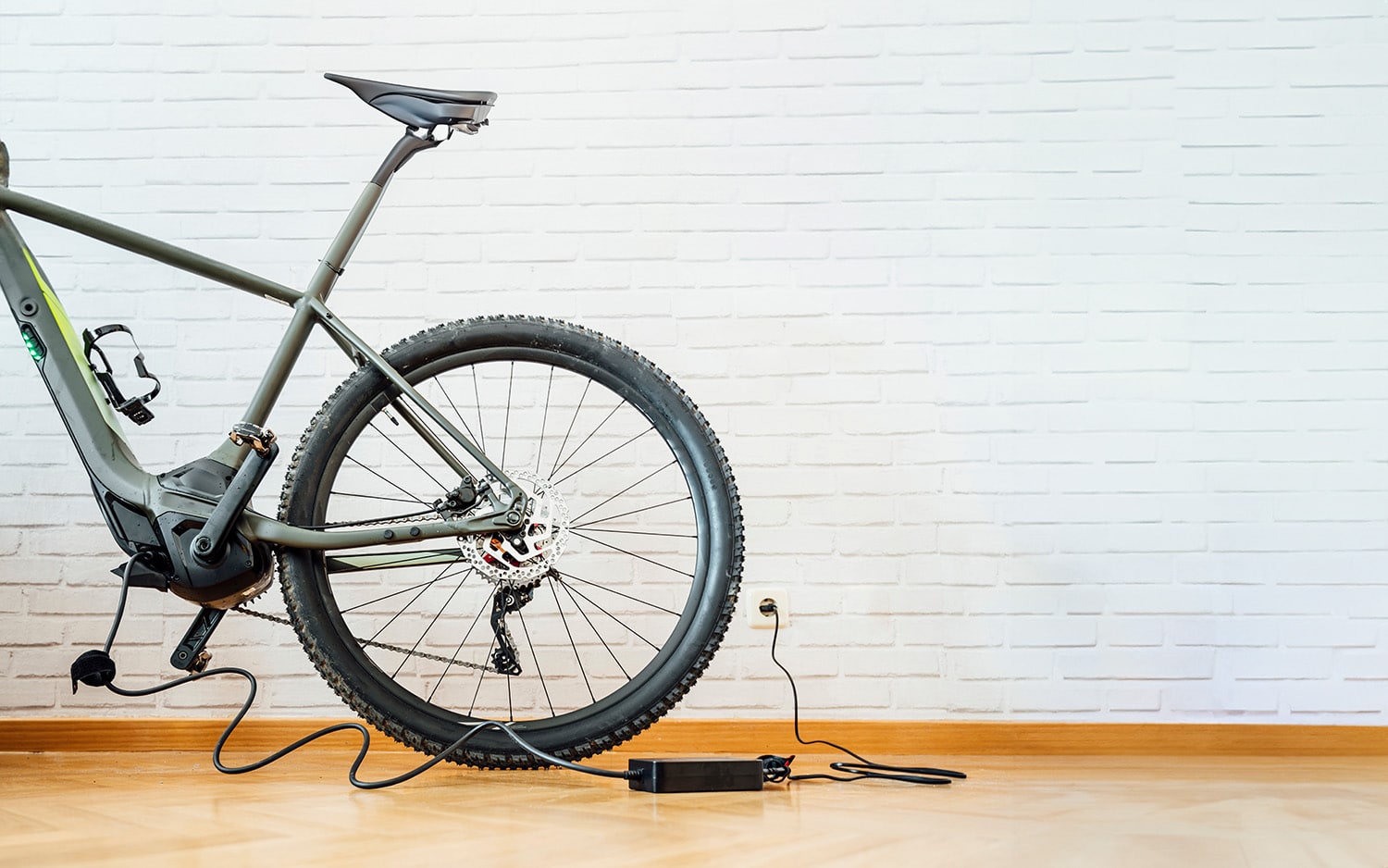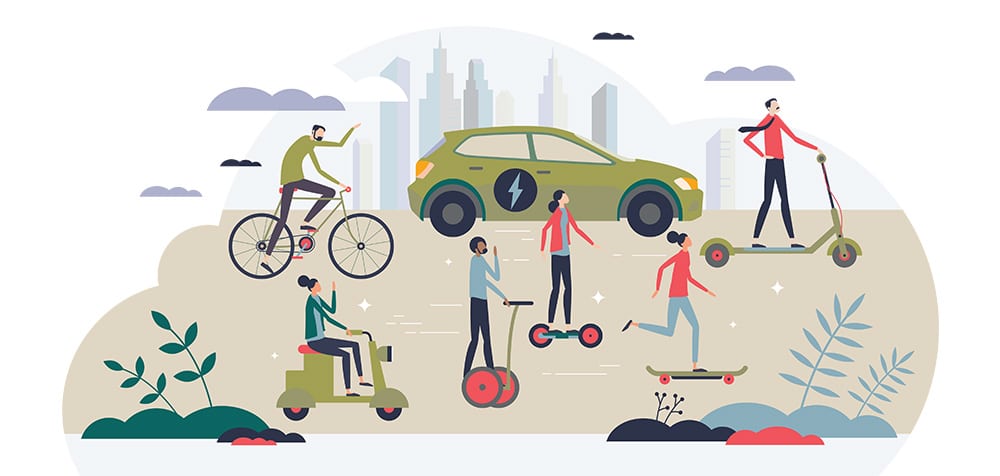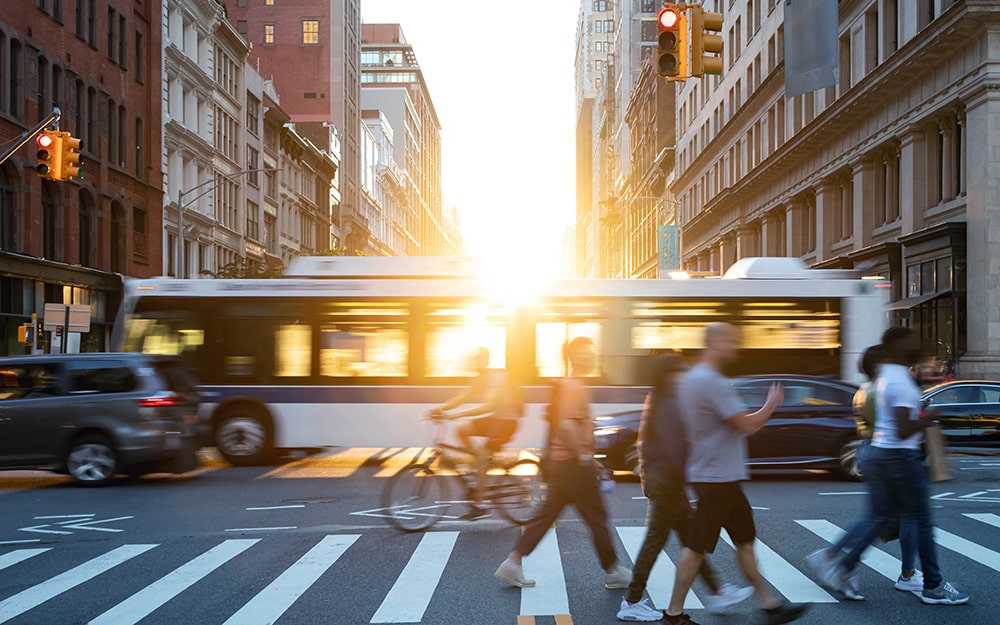
The Times—They Are A-changin’
Transportation no longer means simply driving a vehicle to get
Share:
Share:
Home » Ask the Experts » Modes of Mobility in 2024

“
Public transportation and biking remain the two most impactful alternative modes that our campus community utilizes to, through and from campus daily. We recently partnered with our city partner to improve our on-campus shuttle program by receiving federal funding for 60’ articulated EV buses to increase capacity. Additionally, with us both maintaining Platinum Bicycle Friendly status it makes it easier for folks to choose biking as their daily commute option.”

“
The instability in the micro-mobility market is affecting us directly. Last year, we had a service that was very popular with students, but the vendor was acquired by a European company and ended operations abruptly. We’ve also seen a major player declare bankruptcy, which has put our efforts to replace the service on hold until the market stabilizes. We’ll incorporate the service into a broader transportation master plan discussion.”

“
We anticipate heightened pressure on the public right-of-way from the continued surge in goods delivery and new modes of transportation, such as autonomous vehicles and shared bikes and e-scooters, continue to rise in popularity. The focus in 2024 will be to empower cities with the tools and innovative solutions required to make data-driven decisions and ensure efficient management of streets and curbs for a more sustainable and interconnected transportation landscape. We believe industry data-standards, such as the Mobility Data Specification and Curb Data Specification, and GPS data from connected fleets will be at the center of it all. The future of parking and mobility data will be characterized by advancements in these areas.”

“
The University of California at Davis has been known for its bicycle-friendly campus design. Decades of infrastructure investment are based on providing bike paths and parking areas, and recently, we have experienced an explosion in the number of electric scooters, not just replacing the use of bicycles but also used by those who drive their car to campus or ride transit. We forecast a world where inexpensive electric scooters and/or bikes will replace traditional bicycles or pedestrians. How will campuses handle these increased demands on an infrastructure based on decades of traditional bicycles?”

“
After the launch of our fare-free transit pilot program last year, in 2024 we are evaluating the program’s efficacy in meeting its goals to improve access to safe, affordable, reliable, and sustainable transportation. This will inform the City’s decision on whether to continue the program for the foreseeable future, which is anticipated to change the composition of our funding, the technologies used in our revenue vehicles, and result in other social and economic impacts throughout the community.”

“
The trend of waiving parking minimums for denser, more affordable housing is often solely focused on proximity to transit and fails to consider the essential need for adequate pedestrian infrastructure to access the transit service. Increasing housing density alone does not solve for walkability, and people living in car-captive areas often still rely upon a car to get to jobs and essential services. Focusing on walkability is key!”

“
Look to the skies in 2024 as elevated automated people movers connect LAX airport’s central terminals to off airport rental car/ ride share facility and new LA Metro light rail connection, the K line. A few miles east along the K line, federal approvals recently funded $1 billion for a people mover to connect NFL and NBA stadium entertainment districts in Inglewood to light rail in advance of the 2028 Summer Olympics in LA.”

“
E-bikes are a particular mode that is proving attractive to a wider range of users in our communities. With an appeal that goes beyond just the ‘last mile’ or micro-mobility programs of the past, as well as the boost from rebate programs at the state level, we are seeing more individually owned electric bikes in our neighborhoods. We continue to work with multiple organizations in the region to promote and encourage residents to gain the freedom of an electrified bike ride.”

“
To reduce our collective carbon footprint and increase equitable access to transportation, mobility must evolve in growing cities like Denver. It’s not about adding vehicles. It means strategically and smartly adding bike lanes, micro mobility options like e-bikes and scooters, walking paths, ride share opportunities, expanding bus routes in addition to vehicle electrification are critically important initiatives.”

“
Houston, a traditional, car-centric city, is building a more sustainable future. In 2019, voters overwhelmingly approved funding $7.5 billion in transit projects. The city is building 1,500 square feet of dedicated bike lanes, and we are concerned with curb allocation—but not to the benefit of single occupancy vehicles. Curb parking is being replaced with dedicated bike lanes, expanded sidewalks and transit only lanes. As an organization, we fully support these efforts.”
HAVE A QUESTION? Send it to editor@parking-mobility.org and watch this space for answers from the experts.
The opinions and thoughts expressed by the contributors do not necessarily reflect the opinions and viewpoints of the International Parking & Mobility Institute or official policies of IPMI.

Transportation no longer means simply driving a vehicle to get

Providing Sustainable & Reliable Transportation to City Residents

What is the parking and mobility industry doing to impact


Linking Multimodal Connections

The Evolution of Moving from
One Location to Another

Embracing Smart Transportation in the Dynamic World of Parking and
Parking & Mobility is IPMI’s flagship publication, covering the news, trends, analysis, technologies, and people of the parking and mobility industry, and how it affects and influences communities around the world.
| Cookie | Duration | Description |
|---|---|---|
| cookielawinfo-checkbox-advertisement | 1 year | Set by the GDPR Cookie Consent plugin, this cookie is used to record the user consent for the cookies in the "Advertisement" category . |
| cookielawinfo-checkbox-analytics | 11 months | This cookie is set by GDPR Cookie Consent plugin. The cookie is used to store the user consent for the cookies in the category "Analytics". |
| cookielawinfo-checkbox-functional | 11 months | The cookie is set by GDPR cookie consent to record the user consent for the cookies in the category "Functional". |
| cookielawinfo-checkbox-necessary | 11 months | This cookie is set by GDPR Cookie Consent plugin. The cookies is used to store the user consent for the cookies in the category "Necessary". |
| cookielawinfo-checkbox-others | 11 months | This cookie is set by GDPR Cookie Consent plugin. The cookie is used to store the user consent for the cookies in the category "Other. |
| cookielawinfo-checkbox-performance | 11 months | This cookie is set by GDPR Cookie Consent plugin. The cookie is used to store the user consent for the cookies in the category "Performance". |
| CookieLawInfoConsent | 1 year | Records the default button state of the corresponding category & the status of CCPA. It works only in coordination with the primary cookie. |
| elementor | never | This cookie is used by the website's WordPress theme. It allows the website owner to implement or change the website's content in real-time. |
| viewed_cookie_policy | 11 months | The cookie is set by the GDPR Cookie Consent plugin and is used to store whether or not user has consented to the use of cookies. It does not store any personal data. |
| Cookie | Duration | Description |
|---|---|---|
| _ga | 2 years | The _ga cookie, installed by Google Analytics, calculates visitor, session and campaign data and also keeps track of site usage for the site's analytics report. The cookie stores information anonymously and assigns a randomly generated number to recognize unique visitors. |
| _ga_02PMHW8YWC | 2 years | This cookie is installed by Google Analytics. |
| _ga_LC0QJJHM3J | 2 years | This cookie is installed by Google Analytics. |
| _ga_V9KYTSBYT2 | 2 years | This cookie is installed by Google Analytics. |
| iutk | 5 months 27 days | This cookie is used by Issuu analytic system to gather information regarding visitor activity on Issuu products. |
| Cookie | Duration | Description |
|---|---|---|
| mc | 1 year 1 month | Quantserve sets the mc cookie to anonymously track user behaviour on the website. |
| Cookie | Duration | Description |
|---|---|---|
| ultp_view_1052 | 1 day | No description |
| ultp_view_1058 | 1 day | No description |
| ultp_view_1060 | 1 day | No description |
| ultp_view_1064 | 1 day | No description |
| ultp_view_1068 | 1 day | No description |
| ultp_view_1070 | 1 day | No description |
| ultp_view_1072 | 1 day | No description |
| ultp_view_1078 | 1 day | No description |
| ultp_view_1082 | 1 day | No description |
| ultp_view_1088 | 1 day | No description |
| ultp_view_1100 | 1 day | No description |
| ultp_view_1103 | 1 day | No description |
| ultp_view_1114 | 1 day | No description |
| ultp_view_1118 | 1 day | No description |
| ultp_view_1122 | 1 day | No description |
| ultp_view_1125 | 1 day | No description |
| ultp_view_1130 | 1 day | No description |
| ultp_view_1132 | 1 day | No description |
| ultp_view_1135 | 1 day | No description |
| ultp_view_1541 | 1 day | No description |
| ultp_view_1554 | 1 day | No description |
| ultp_view_1557 | 1 day | No description |
| ultp_view_1560 | 1 day | No description |
| ultp_view_1563 | 1 day | No description |
| ultp_view_1568 | 1 day | No description |
| ultp_view_1572 | 1 day | No description |
| ultp_view_1576 | 1 day | No description |
| ultp_view_1580 | 1 day | No description |
| ultp_view_2305 | 1 day | No description |
| ultp_view_2321 | 1 day | No description |
| ultp_view_2338 | 1 day | No description |
| ultp_view_2342 | 1 day | No description |
| ultp_view_259 | 1 day | No description |
| ultp_view_270 | 1 day | No description |
| ultp_view_275 | 1 day | No description |
| ultp_view_286 | 1 day | No description |
| ultp_view_3074 | 1 day | No description |
| ultp_view_3115 | 1 day | No description |
| ultp_view_3334 | 1 day | No description |
| ultp_view_3336 | 1 day | No description |
| ultp_view_3338 | 1 day | No description |
| ultp_view_3340 | 1 day | No description |
| ultp_view_3346 | 1 day | No description |
| ultp_view_3354 | 1 day | No description |
| ultp_view_3361 | 1 day | No description |
| ultp_view_3367 | 1 day | No description |
| ultp_view_365 | 1 day | No description |
| ultp_view_367 | 1 day | No description |
| ultp_view_38 | 1 day | No description |
| ultp_view_3846 | 1 day | No description |